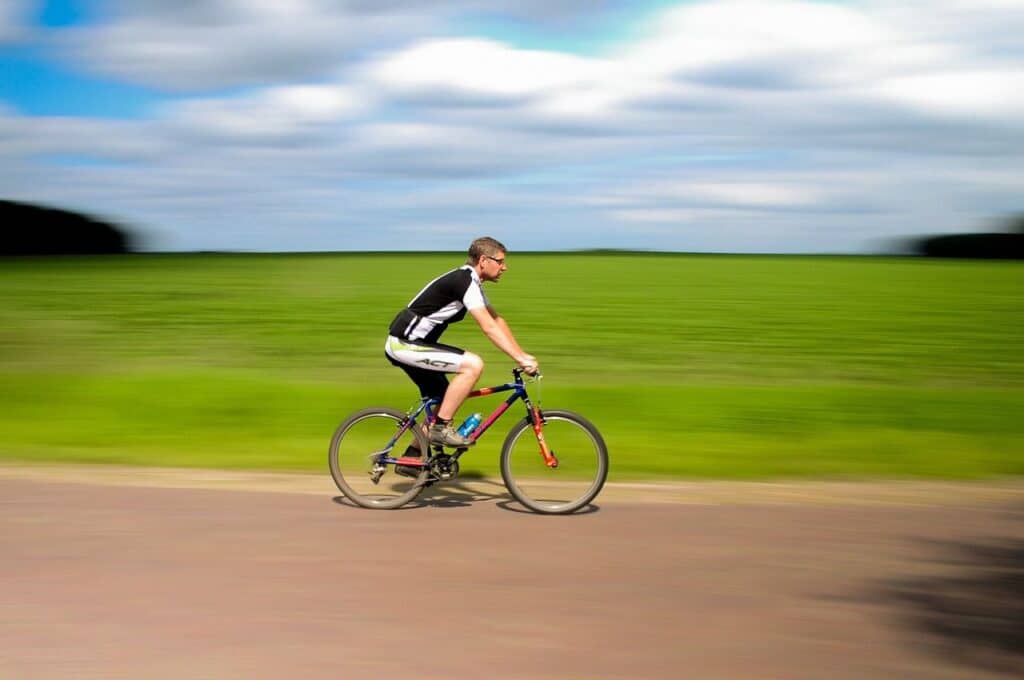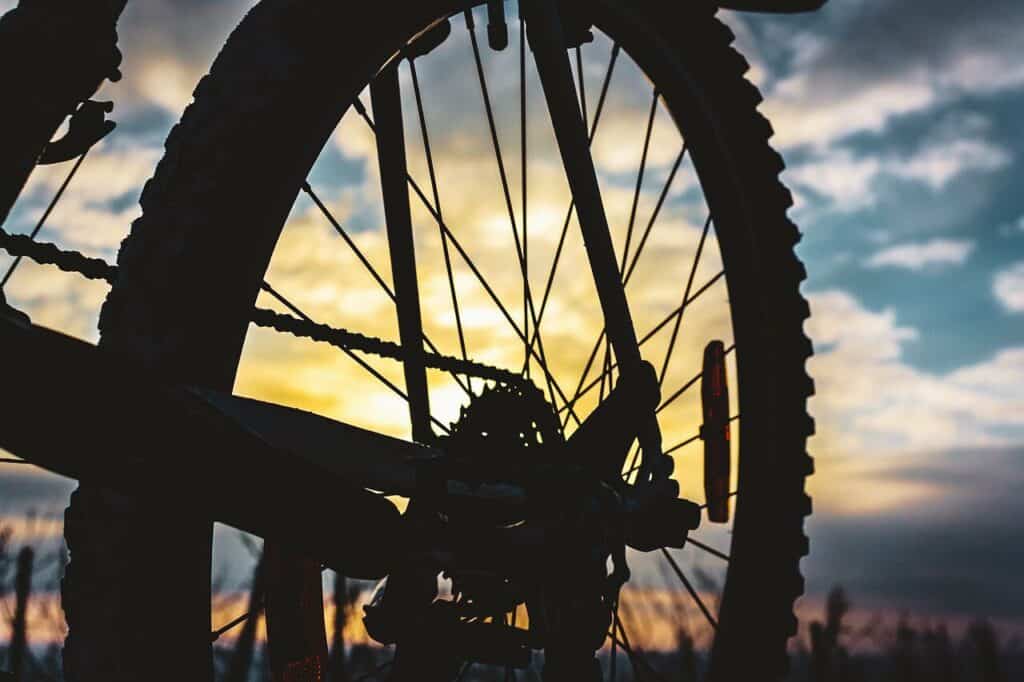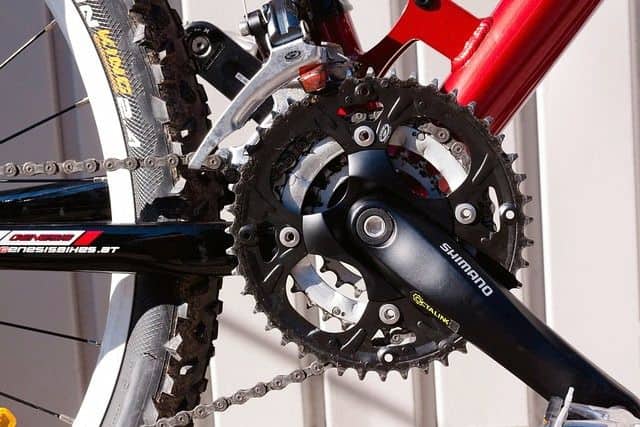Mountain bikes are excellent options for heavy riders due to their strength and endurance. While purchasing a mountain bike (which can cost between $1,000 to $6,000-plus!), heavy riders should consider factors such as the number of spokes in the wheel, wheel size, tires, frame, gear/braking system, etc.
Many heavy riders have embraced cycling, but few dare to venture into the mountain bike territory for many reasons, the most common being finding a bike that suits their weight and supports mountainous adventures just as it supports lighter riders.

We’re here to tell you that you no longer need to fear this—there are plenty of mountain bikes for you – big guys and gals. You need to know where and, more importantly, what to look for.
If you’re considering investing in a mountain bike and are wondering how to choose a mountain bike for heavier riders, here’s the guide you need.
Table of Contents
Types of Mountain Bikes
A well-designed mountain bike can help overweight riders confidently conquer rough terrain, but not all bikes are up to the task.
In your search for the right mountain bike, you will encounter different types of these bikes. To help you make sense of these, here’s a breakdown of the four (most common) types of mountain bikes.
All-Mountain Bikes
All-mountain bikes are also known as Enduro bikes, as they’re the centerpiece of this highly challenging motorcycle sport that takes bikes (and bikers!) through challenging climbs and extended off-road courses.
An all-mountain bike is bulky and features more technical features than other types of mountain bikes to help bikers quickly and efficiently navigate the obstacles on the path.
They balance being powerful enough to conquer steep descents while being lightweight and agile enough for the rider to pedal through tough ascents.

All mountain bikes are perfect for riders looking to participate in the Enduro race or those who don’t mind pedaling uphill to enjoy the airtime of a downhill descent. They’re also great if you simply take laps around the bike park.
Some of the main features of this type of bike:
- An angle of 65° to 68° in the head tube
- Between 140 and 170 millimeters of full-suspension travel
- Average body weight of 30 pounds
- The ability to adjust the suspension in many models
- Wheels typically 27.5 or 29 inches (though some bikes may feature both)
Cross-Country Bikes
For riders who prioritize pedaling performance, climbing prowess, and speed, cross-country bikes tick all the right boxes.
Due to the similarities in the build they share with trail bikes, beginners may confuse the two, but cross-country bikes are much lighter and more powerful.
These lightweight bikes, built for efficiency and endurance, breeze through uphill terrain and make short work of long distances.
This is why they lie at the center of cross-country racing, where riders need to navigate various terrains, from gravel to forests to slopes to fields. However, you can also use these for speedy rides on local trails.

The focus on climbing well, however, means that you’ll have to settle for lower downhill performance than other types of bikes.
Some of the main features of this type of mountain bike:
- Extremely lightweight (some models weigh less than 24 pounds)
- Typically features front suspension only, ranging between 80 and 100 millimeters
- A head-tube angle of 70° or 71°
- 29-inch wheels that favor faster-rolling resistance and reduced weight over durability, control, or traction
Fat-Tire Bikes
Also known simply as fat bikes, fat-tire bikes are easily recognizable, as the name implies, by their oversized tires—typically twice the size of traditional mountain bikes.
The primary purpose of these oversized tires is to effortlessly navigate surfaces that don’t provide great traction, such as ice, snow, and sand.

Fat bikes are excellent even otherwise, especially for heavy riders and beginners who are just learning to make their way through rough terrain.
Some of the primary features of this bike type:
- Typically, they do not have a suspension system, and the tire pressure is kept lower than normal to absorb shock better
- Wheel width ranging between 3.7 to over 5 inches
- It can be a steep or slack head-tube angle (closer to 90° or 66°, respectively)
- Wheel size can be 26 inches (generally found in older models) or 27.5 inches
Downhill Bikes
Rounding off the list are downhill bikes, made to navigate steep trails as quickly as possible. With these bikes, you can make short work of jumps, rough terrain, and big drops without so much as flinching or dropping your speed.
These bikes are easily identifiable by their thick tires, wide handlebars, and saddle kept low for the ideal center of gravity.
They’re also heavier than other types of mountain bikes so that the stress and shock of large jumps don’t damage them. The thickness of their tires allows these bikes to have an excellent grip.
However, as the name suggests, these bikes are only meant for downhill rides. Riding uphill with these is a Herculean task and, in some cases, even impossible.
This means you’ll need to carry the bike up with you by means such as chairlifts, shuttles, or hiking.
Therefore, opt for this bike only if you can easily carry it up the slope and have the skill to handle the airtime and high speed that this type of mountain bike affords when descending.
Some of the main features of this mountain bike type:
- Suspension between 180 and 25o millimeters (usually between 180 and 200 millimeters in the front and 170 and 250 millimeters in the rear)
- Average body weight of 35 pounds
- Extremely slack head-tube angle (lower than 65°)
- Two-ply casings on tires for enhanced durability and traction
- Wheel size can be 27.5 or 29 inches
Factors That Heavy Riders Should Consider When Buying a Mountain Bike
For heavier riders, keeping in mind a few factors will help you find durable, strong bikes that allow you to ride comfortably and don’t give out in a few years. Here’s what you should look for:
The Frame: For heavy riders, aluminum and steel frames are better than carbon fiber.
Steel works out the best, thanks to its relative elasticity.
Additionally, unlike carbon fiber, you won’t face issues with spontaneous or sudden failure; these frames gradually deteriorate, and even then, may tear or bend and not completely fall apart.
Aluminum is cheaper, but it gets stiffer and more brittle with prolonged stress. However, for your aluminum frame to reach a point where you can’t salvage it will take decades, so this isn’t something to worry about with brand-new bikes.
The Number of Spokes: The ideal number of spokes is 36 on the rear wheel and 32 on the front wheel. Anything less, even in the name of weight saving and “aero”, will not be stable enough for heavier riders.

Some bikes even have 40 or 48 spokes, but you’ll pay considerably higher than average for such reinforced strength.
The Wheel Size: The larger the diameter, the stronger the bike. A seatpost of 31.6 millimeters is ideal for heavier riders.
Suspension: If you plan to only bike through relatively tame terrain, the suspension is negotiable. Many heavy bikers forgo suspension since it adds considerable weight to the bike, increasing the risk of damage.
If speed is important and you need the confidence to navigate extremely bumpy terrain, you can consider bikes with suspension. However, make sure that the bike’s suspension limits suit your weight.
Additionally, opt for tuneable air suspension over coil-based suspension; the former only requires an air-shock pump, while the latter will require an experienced mechanic to help you set it up.
Tires: If you’re only planning to use your mountain bike on smooth roads, look for tires that don’t have many knobs. A width of 2 to 2.5 inches should suffice, even for the average mountain path.
However, for hardcore mountain biking, you’ll need tires that have good width, traction, and grip, such as the ones fat bikes use.

Additionally, look for double-alloy rims.
The Seat: As comfortable as squishy saddles look, the reality of these soft seats is quite different.
The truth is that regardless of the type of seat your bike has, saddle sores are inevitable for the first few weeks of consistent riding. Look for ample width to support your frame and decent padding to keep things comfortable.
Pedals: Flat pedals are more efficient if peddling is your priority and way more comfortable than cleats or clips.
Most heavy riders face issues with the cheap plastic pedals that most box-store bikes come with, so you may need to replace your pedals with something stronger if this is the case.
Riding Position: An upright riding position is more comfortable for heavier riders, especially those who carry a lot of weight on their thighs and stomachs.
Riding bent over can be uncomfortable and squeeze the air out of you, leaving you breathless on long-distance rides. It can also lead to back and hip issues by forcing your knees to the side.
Powerful Brakes: A higher weight means more momentum is generated, which means you need more force to stop your bike. Mechanical disc and rim brakes can generate the force required to stop, but only if you can generate the hand strength to apply this kind of force on the brakes.
Hydraulic brake systems are the best, staying strong through wet and dry weather. They don’t require much force to stop effectively or much maintenance.
When they do eventually wear out, after years of consistent usage, they’re easy to replace.
When it comes to the rotors, six inches are sufficient if you don’t plan on getting airtime down tough slopes. If you do, look for rotors that are eight inches or larger.
The Gear System: Just as larger bodies generate more force, moving them through space requires more effort. While pure pedaling power can also get you through this, a good gear system with higher torque will make the process much easier.

While three gears suffice for city riding, heavy riders navigating rough mountain paths require at least seven or more gears.
Another point that many cyclists will suggest you consider is the bike’s weight limit. However, many heavy riders don’t place too much emphasis on this and even happily ignore it, finding that their weight is well-supported even with standard mountain bikes.
Bear in mind, though, that not considering the weight limit will void any warranty on the bike.
Additionally, don’t forget to invest in a strong chain that can handle a good bit of stretch and wear.
Big guys and gals can apply more torque than required without meaning to, especially when navigating obstacles or ascents.
This is one component that also requires frequent checking and maintenance.
Budgeting for a Mountain Bike
How much you set aside for a mountain bike depends on whether you want to buy a new or second-hand/used one.
For new bikes, anywhere between $1,000 and $2,000 is reasonable (though there are specialized bikes that cost well over $6,000, too!) and will get you a decent bike.
Make sure that for this price, though, the retailer or department store sets up the bike as per your requirements. You don’t want to spend even more on professional mechanics to set up your bike after its purchase.
Most heavy riders prefer to stay away from box-store bikes. These mass-produced bikes are often of inferior quality since the manufacturers prioritize cutting costs over ensuring quality.
Many riders face issues with the rims, which are often the first parts to give out or break when exposed to even slightly rough terrain or long distances.
If you plan to buy a new bike, you should go to a specialty bike shop. Even if you don’t buy a bike from these stores, you can walk out with excellent suggestions 99% of the time!
For used bikes, the price may run even lower than $1,000, depending on the seller.
However, whether you’re buying a new or used bike, always try to buy the bike after trying it for its size and fit. Make sure the saddle, handlebars, riding position, frame, etc., suit your needs.
Additionally, with used bikes, scrutinize the frame. You don’t want dents and cracks to shorten your bike’s lifespan further.
Some Suitable Mountain Bikes for Heavy Riders
If you’re having trouble narrowing down the options (we get it—the array of options can be quite dizzying!), here are our top three picks for mountain bikes for heavy riders.
SavaDeck Deck 6.0
Lightweight, inexpensive, yet strong—the SavaDeck Deck 6.0 is the perfect entry-level hardtail mountain bike for heavy riders. With a 100-millimeter travel fork packed into it, this bike is ideal for soft trails, while the unbeatable Shimano M6000 rear and front disc brakes give you excellent stopping power.

However, many riders may not like the bike’s carbon fiber body, which makes it a little challenging to operate, even if it does keep you extremely safe, regardless of how crazy you go on your descents!
The wheels are available in 27.5 and 29 inches, which makes pushing the bike up a hill (which is the only way to take it up the slope) slightly less challenging.
Mongoose Dolomite
With its 26-inch wheels, rigid fork, steel frame, and fail-proof tires, the Mongoose Dolomite is pure power in the form of a fat bike.

Mud, snow, ice, or deserts, this bike can easily and safely get heavy riders through a range of terrain, and the best part is that you won’t miss the suspension with this bike, though it doesn’t come with a suspension system.
The Dolomite features mechanical disc brakes for enhanced performance, and though you won’t enjoy much speed with this bike, the efficient braking system is a great safety feature to have in place.
Despite all its features, the bike is incredibly affordable, making it great even for beginners.
Ibis DV9
Rounding off our top three is the Ibis DV9, a hardtail cross-country bike with 29-inch wheels, a 120-millimeter travel fork, and a carbon fiber frame.

Among the best hardtails in the market, thanks to its features, the Ibis DV9 is a good option for slightly advanced heavy riders looking for a strong mountain bike with a wide gear range to navigate challenging terrain consistently.
Just as good in descents as in ascents, this bike’s overall strength and efficiency make it an excellent option for heavy riders who are seriously into mountain biking.
The Bottom Line
As a heavy rider, mountain bikes are some of the best (if not “the” best) bike options in the market. These bikes are built for endurance and strength, and even if you don’t use them for rough terrain, you can just as easily enjoy them within city limits.
If you were wondering how to choose a mountain bike for a heavier rider, you now have all the ammunition you need. Find the right mountain bike, and don’t be surprised if you never want to get off the saddle!